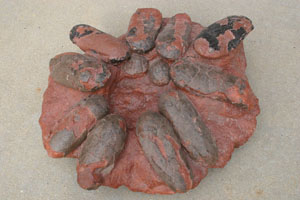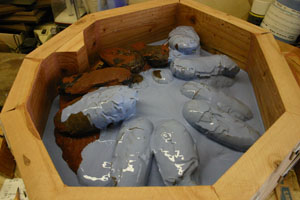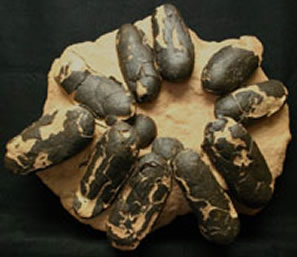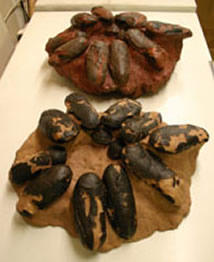Oviraptor philoceratops egg nest - cast
This is our Oviraptor nest in the making. This original also had a considerable amount of matrix attached to the back for protection. So, again we created a hole and dropped the piece into it to create a more asthetic reproduction. The original had to be carefully studied and prepared to make certain any potentially hazardous cracks, gaps, and holes are filled with clay. This process normally takes a day or two depending upon the fossil in question. And then takes an equal amount of time to removed the clay after the specimen is removed from the mold.
The next step is to make a frame which will fit around the fossil. The frame should be no closer than 3/4's of an inch from the fossil. The height of the walls of the frame should be at least 1/4 inch above the highest point on the fossil. These allowances will help insure the integrity of the mold, to help keep it from tearing or puncturing. Care should also be taken not to put any pressure on areas where the depth of the mold is thinest, when working with the finished mold. This piece, along with the Tarbosaur egg clutch, used the balance of our $1000.00 bucket of silicone. So, this nest was also about $500.00 to create. The silicone we use is the most expensive of the different varieties which are available. It has a much higher resistance to compression, which prevents distortion on the edges of the cast. It also resists tearing, which is also one of the great risks of some of the other molding materials. I will discuss this further in the discussion of the mold for the Hyaenodon skull. A frame for a piece can take any where from a couple of hours to a couple of days to make, depending on its complexity. Due to the expense of the molding material, we are spending much more time making our frames. We try to leave fewer dead spaces inside the frame which are not occupied by the fossil itself. This requires a little more thought, but can potentially save hundreds of dollars. Had we poured the mold as you see it to the right, the mold would have cost about $850.00 to $900.00 to make. We filled the top edges with carefully fitted wood pieces and saved about $300.00 to $400.00. This helps us bring the piece to you, our customers, at a less expensive price. Every body wants to save a little money.
Photograph number three is a painted copy. You will notice that the matrix is a lighter color than the matrix of the original specimen. That is because the preparator used polyurethane to cover and preserve the original specimen. When you put polyurethane on a rock it makes it look wet or polished. The area in Mongolia where the original nest was found is called the "Flaming Cliffs;" probably due to their color when they are wet. We used a color for the matrix from an area where no polyurethane was present. We also darkened the egg shell to match the color of two of the back eggs from the original nest. The natural color of the eggs can vary anywhere between those in front and the two in the back. So, we chose, again, to make the piece as asthetic as possible and still maintain a natural look.
The last photograph shows a painted copy in the foreground and the original specimen in the back for comparison.
.

Original Oviraptor egg nest

Silicone molding material being applied to eggs

Painted cast of Oviraptor nest

Original nest in back, cast in front